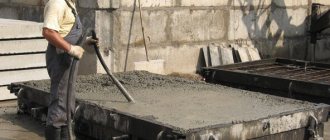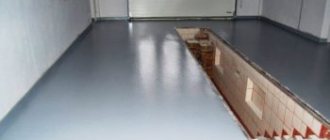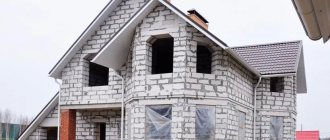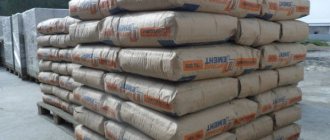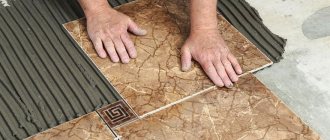Many people think that pouring concrete is easy. But if the technology is violated, after a couple of years, and sometimes even earlier, concrete surfaces begin to crumble. Cement work requires certain knowledge and skills, as well as compliance with the rules for preparing and pouring the mixture. If the master takes into account all the subtleties of concrete work, the integrity of the surface is maintained much longer.
Concrete is collapsing and crumbling - what to do?
Concrete is a building material that is obtained by mixing sand, cement, crushed stone and water and, if necessary, can have special additives to increase the strength of the solution. Concrete has many advantages: frost resistance, water resistance, high strength and longevity. Various building elements are made from concrete mortar, buildings and structures are erected. But, like any building material, concrete is subject to deformation, in particular, crumbling. Why do concrete structures collapse and what to do if the concrete crumbles? Such questions are asked by property owners whose concrete mortar has crumbled, then they look for possible ways to eliminate the problem and prevent its further formation.
Chemical factors
During the operation of reinforced concrete structures in the air, they are significantly affected by all acid gases. Since the main substance of this class contained in the air is carbon dioxide (the concentration of CO2 is several orders of magnitude higher than the concentration of other acid gases), it is considered to be the main factor of influence. Carbon dioxide, interacting in the presence of moisture with concrete components (lime hydration products, in particular Ca(OH)2), causes the formation of calcium carbonate (CaCO3) and H2O according to the following reaction:
There are other mechanisms for the interaction of carbon dioxide with different reaction products. But, in general, this process can be characterized as intense, due to the high ability of concrete to absorb moisture and carbon dioxide from the atmosphere and diffusion and capillary transfer into the volume of the material. It should be taken into account that at the first stage the carbonization process can be considered as positive, since the resulting calcium carbonate has less solubility than calcium hydroxide, which leads to an increase in the strength of concrete. Since CaCO3 tends to clog existing pores, the process of penetration of gases deep into the structure slows down.
Protection of concrete - how to ensure?
There are two main ways to prevent the destruction of concrete:
- 1.Primary. The use of certain mineral compounds that increase the density and frost resistance of the material. It is important to take into account one nuance here. Such compositions can be introduced only in accordance with production technology and under the supervision of specialists.
- 2.Secondary. Application of coatings for concrete. This includes special varnishes and paints, acrylic coatings, and waterproofing protection.
To carry out repairs of concrete structures, it is also recommended to use dry building mixtures. Their use will help increase the density and water resistance of the material, increase its strength, reduce shrinkage and reduce the likelihood of cracks.
As with many diseases, prevention can help prevent concrete deterioration. It should be carried out initially, both at the stage of preparation for construction and during the process. If a concrete structure is placed in any room, such preventive measures should consist of reliable sealing of pipelines and ventilation systems. It is important to carefully consider the arrangement of drainage structures; provide anti-corrosion protection, etc.
Necessary protective measures
Specifying all of the above, it should be noted that the following measures can extend the service life of a concrete structure:
- 1.Increasing the density of concrete. It will not allow the aggressive environment to penetrate far into the material.
- 2. Reducing the mechanical impact on the structure or its uniform distribution.
- 3.Use of high-quality materials that are more resistant to aggressive environments.
- 4. Closing cracks that have already appeared with a special solution. Under no circumstances should the appearance of cracks be ignored. In conditions of temperature changes, the problem will only worsen.
- 5.Applying a special impregnation to the surface - a composition that prevents destruction and has water-repellent properties. Interacting with concrete, it is able to quickly penetrate deep and act as a screed for the base itself.
- 6.If the reinforcement of a concrete block is corroded, its cross-section can be restored by welding reinforcing bars.
- 7. Areas of corrosion that have appeared in the concrete are removed and then replaced with a better material.
- 8. A deformed area or structure that cannot be repaired should be replaced (if possible) or dismantled.
- 9.The correct solution would be to protect the foundation of the building from excess moisture by covering it with ceramic tiles.
- 10. If the foundation begins to deteriorate, you can partially replace a section of it. However, this is a very expensive type of repair.
In some cases, carrying out work to restore a concrete structure may turn out to be unprofitable and unprofitable. Then the only correct solution would be to completely replace it. But knowing the methods and methods of protecting the material from negative factors will most likely help prevent the problem. It is also possible to stop the destruction of concrete if this material is used correctly.
Stage 3 - installation of wooden formwork. In order for the concrete coating to take the required shape and have the established dimensions, wooden formwork is erected. Sometimes metal or plastic is used as formwork material. However, the most convenient and affordable materials are wooden boards and beams.
The boards are installed along the perimeter previously marked with pegs, so that a shape of the required height is obtained. The boards are reinforced with supports. It is important to note that when pouring, the concrete will exert strong pressure on the formwork, and it may become deformed. To ensure the reliability of the entire structure, it is necessary to install stops that prevent the structure from deforming to the outside. If there is a small distance between the formworks, it is advisable to fasten them together to strengthen the entire structure.
Restoring a concrete countertop
Concrete countertops are rarely found in the houses and apartments of our fellow citizens. But very often such products can be found on garden tables and market stalls. Minor damage to the surface does not seriously affect its performance properties, but, unfortunately, under the influence of external factors, they can turn into deep defects and cracks. In addition, damage makes the product unattractive and contributes to the retention of dirt on its surface and the proliferation of microorganisms.
The easiest way to restore concrete countertops is to thoroughly sand them using an electric hand sander. This work must be performed wearing safety glasses, a respirator, gloves and protective clothing. Grinding begins with processing with the largest abrasive attachments, gradually reducing the grain size until a perfectly smooth surface is achieved. This procedure is quite “dirty”, so if possible, it is better to perform it away from home.
After the surface has acquired the proper smoothness, it can be polished using mastics designed for working with natural and artificial stone.
Concreting the yard performs the following tasks:
- A flat, durable surface that can withstand a lot of weight, be it a gazebo structure, or parking a truck, without collapsing or deforming the surface;
- This coating is much easier to keep clean, since there is no need to pull out weeds and if dirt suddenly collects, it can be easily washed off with water pressure;
- In addition, it is easier to remove snow and ice from a concrete site, which is very important for almost all regions of our country;
- Gives an aesthetic and well-groomed appearance to the area. This method helps to zone spaces, allowing you to create comfortable places to relax;
- And, of course, the concrete pad can be used as a flat, prepared surface for laying other materials.
In order for concrete to last as long as possible and maintain an attractive appearance, it is necessary to follow concreting technology and comply with certain conditions for pouring it.
Strengthen the foundation or eliminate the cause
The conclusion that suggests itself: first eliminate the reasons that cause changes in the foundation (its destruction) and natural violations of the integrity of the house built on it. Let's look at the most common reasons:
- the foundation was initially built in violation of technology. In this case, it is definitely necessary to strengthen it;
- changes in the foundation of the house are associated with increased soil moisture. In this situation, much attention is paid to the blind area of the foundation; if necessary, drainage of the foundation is arranged. We will talk about the latter solution in one of the following articles;
- The site chosen for construction has a heterogeneous soil composition, which leads to local deformations of the foundation of the house. As an effective solution, a set of measures is used, including strengthening and insulating the foundation, drainage, and, if possible, replacing part of the unstable soil with crushed stone and sand.
To summarize the above: first, you should take care of additional thermal insulation of the soil layers located under the foundation and next to it (this measure will reduce heaving phenomena, if such are typical for your site), and also ensure minimal humidity of the site near the base by developing a drainage system. Only after this can you think about serious work to strengthen the foundation.
Preparatory work - step-by-step instructions
Waterproofing a balcony is never done without prior preparation. Its essence is to ensure the most effective penetration of insulation. Since the treatment requires exposure of the concrete base, the extent of preparatory work may vary in composition. You may have to remove the old screed or wood flooring.
In advanced cases - with partially destroyed concrete structures, the repair composition Skrepa M500 is very appropriate. The mixture is used for the restoration and repair of concrete and belongs to the Penetron system of waterproofing materials.
Exposed reinforcement, if any, is cleaned and treated with an anti-corrosion compound. The cracks are opened for subsequent filling with screed or filling with plaster. Before leveling the surface, it is thoroughly cleaned of debris and dust, and then primed. The last stage is the actual alignment. It is recommended to make an expansion joint around the perimeter of the balcony - between the walls and the floor. It will prevent cracks from appearing. The seam (before pouring the screed) is filled with foamed polyethylene and then sealed with elastic sealant.
Installation of drainage systems
The waterproofing system may include drainage systems. Of course, this cannot be classified as preparatory work, but in many cases these are additional water protection measures. The simplest system is a ladder that is mounted at the bottom of the balcony floor.
Why does destruction occur?
There are many reasons and circumstances influencing the collapse of concrete buildings, among which are:
- Moisture entering the cracks and spaces of the building material at a time of low temperature tends to expand, thereby forming expanded voids. As temperatures increase, the pores decrease in size and moisture fills the resulting space. As a result, cracks form that destroy the concrete structure.
- Air temperature difference. They can be seasonal or technological. To prevent damage to the concrete composition from temperature changes, use insulating material or a frost-resistant solution.
- Poor quality of concrete, laying structures with stale cement or violation of the ratios in its production.
- Failure to comply with the rules for caring for a concrete structure at the time of fastening, strengthening stability and hardening. It is taken into account that in the summer the freshly poured mold should be systematically sprinkled with water and covered with polyethylene, and in the winter it should be warmed up with heating cables, professional materials and other methods.
Such defects can appear when the poured material was not properly watered and covered with cellophane as required by the rules.
Conditions and features
A drilled injection pile is a structure that is obtained by replacing the soil extracted during drilling with a mixture of concrete (with a reinforcing frame).
The scope of application of these load-bearing elements extends to the following cases:
- carrying out work on unstable loose soil, where it is necessary to carry out additional strengthening of the pit walls;
- construction of high-rise buildings in dense buildings;
- carrying out work in historical architectural centers;
- the need to install supports with a given angle of inclination;
- construction of extensions, additional floors to an existing building.
An old strip foundation installed on such pile supports looks like this (photo):
Foundations can be placed nearby
In industrial construction, drilled injection piles are classified as a type of bored structures that are used in the construction of buildings in densely populated areas of cities, when it is impossible to install piles using the driving method, as well as on sloping soils.
Changes in the operating conditions of the building (increased load on the foundation, rising groundwater levels, excessive water saturation from the surface of the surrounding soil, wear and tear over the service life of load-bearing underground structures, man-made vibrations) lead to uneven settlement of the building. The ability to stop the destruction process is provided by the method of installing concrete supports at any angle without destroying the old strip base.
Drilling technology with immediate filling with ready-made solution is used to strengthen slopes in order to prevent the gradual destruction of unique landscapes. An example of the use of technology is preventive work to ensure the safety of the almost vertical Chalk cliff (Svyatogorsk Lavra).
Design differences
According to the technological features of manufacturing and operation, drilled injection piles are divided into 2 main categories:
- Hanging. They transfer the main load to the surrounding soil with their lateral surface. This need arises in an area where the soil does not have hard rocks to provide a load-bearing function and create a solid foundation for the building.
- Racks. The pillars distribute the load from the above-ground structure not so much over the side area, but over a wider area of the heel. Such elements are used for buildings in difficult areas to ensure that there is no vertical displacement of the soil along the walls of the well along the support. These qualities are in demand when carrying out capital work on the reconstruction of bridges, overpasses, and strengthening the foundations of emergency buildings.
The process of repairing emergency foundation subsidence is shown in this photo:
Saving an existing building
To strengthen the foundation with self-leveling concrete pillars, large-sized machines and equipment available from industrial giants are not always used. Instead of a self-propelled drilling rig and a mobile concrete plant, a mobile machine with a type-setting drill, a concrete mixer and a welding machine are enough to independently produce frames from reinforcement.
In individual construction, small-sized units are used that can serve only 2 people. The high speed of work is also due to the fact that it is not necessary to carry out a large volume of associated excavation work for other types of concrete foundations.
Technology differences
The time for manufacturing and installation of a drilled injection pile (BIS) is combined with its production technology. The cement solution is poured into the finished well at the moment the drill moves back through the internal channel passing along its vertical axis. This significantly saves construction time and allows the use of existing undamaged soil walls as formwork.
The sequence of all stages of creating an encore
When constructing multi-storey buildings, a significant length of the column is required - about 15 m. In such cases, reinforcement can only be performed in the upper part of the support.
The cement mass is injected using a high-pressure concrete pump to ensure uniform distribution of the concrete solution along the entire length of the well. The strength of the monolith also increases due to the absorption of particles of the surrounding soil by the outer layer of liquid material.
Solution supply
The main difference between this technology and the installation of bored concrete piles is the method of entering the injection cement mortar (concrete with fine filler or cement-sand mixture) directly through the drill into the well.
Recovery process
Restoring a concrete walkway begins with identifying its defects and acquiring the necessary materials and tools.
From your inventory you may need:
- Building level;
- Washing machine;
- Chisels;
- Boards;
- Wooden stakes;
- Container for preparing the solution;
- Master OK;
- Grater;
- Brush;
- Sackcloth.
Materials you will need:
- Fine sand;
- Cement;
- Putty for external use;
- Metal pipe;
- Portland cement.
Before repairing a concrete path, it is necessary to complete the preparatory stage. This includes not only purchasing the necessary tools and materials, but also cleaning the areas being repaired.
To do this, it is better to use a washing machine with a guide under a certain pressure and a stream of water. This unit makes it easy to remove moss, dirt, loose parts of concrete paths and other elements.
Repairing cracks in the walkway
Advice: If there is severe damage and a large number of small cracks, the coating should be completely changed. And in case of single damage, small cracks are sealed with fresh mortar, which will ensure the durability of the coating for several years of its operation.
Most often, owners of their plots have to seal cracks in concrete paths.
Work instructions:
- Debris, dirt, mold and grass are carefully removed from the cracks;
- For high-quality adhesion of the mortar to the surfaces to be repaired, it is recommended to deepen the potholes to two centimeters, with a slight expansion of the crack;
- A solution is prepared in a prepared container. You can stir it by hand, but it is better to use an electric drill with a special attachment attached;
- For narrow cracks, sand and cement are mixed in a ratio of 3:1;
- A cement-gravel mixture with fine fractions is prepared for wide cracks;
- It is better to lay reinforcement made of large diameter wire into a deep crack.
- Small cracks and holes can be filled with an exterior compound. This can be quick-drying cement or mortar to which sifted fine sand has been added;
Tip: When sealing cracks in concrete, it is worth purchasing a set of a ready-made primer polymer composition for treating the edges of cracks and a dry ready-made mixture, which contains sand, cement and astringent polymer additives.
- The solution is brought to the consistency of sour cream;
- The composition is carefully poured into the crack and carefully leveled over its entire length;
- The mixture is pierced inside with a spatula to ensure that the entire volume is filled with the solution;
- The sealing areas are leveled with a metal trowel or trowel. In this case, you need to ensure that the edges of the cracks do not protrude too much above the surface of the main concrete covering;
- The surface is leveled with a regular brush, in the absence of special power tools. This will help push out the air and roughen the surface, making the areas less slippery;
- To enhance the adhesion of the mixture, it is recommended to apply PVA glue to the surface.
Tip: In hot weather, to prevent the seal from drying out too quickly, you should lay a sackcloth or a rag moistened with water on top of the crack.
Preparing the surface for repair
Restoration of canvas edges
Along with the formation of cracks, pieces of the fabric break off on the side especially often. The reason for this is usually a missing curb when the concrete was poured.
Buy curbstones in different sizes
Like vibropressed tiles, borders vary in thickness, length and width. The following options are produced at production in the Istra region:
- large-sized road, dimensions 1000x300x150 mm;
- road standard, flat, - 1000x200x80 mm;
- garden dimensions 500x200, thickness 30 or 60 mm;
- garden with top bevel, 500x210x70 mm.
During the production process, we use first-class concrete mixtures based on Portland cement and plasticizers, which add strength and resistance to external influences to the products. Proficentre also uses special powder pigments to color the solution in the mass. Thanks to this, you can order not only gray, but even brown and red, as well as yellow fencing elements.
Our borders do not collapse during prolonged contact with the ground and can enclose both a flower bed and a path. In addition, they are characterized by increased resistance to weathering and temperature changes.
Advantages of concrete curbs
Durable concrete curbs help to enclose an area or path, complete the design, and define the shape. They perform a dual role: they are used both as a finishing decorative detail and as a protective element that prevents the blind area from spreading. The underlying layers and FEM cannot move or move apart, since they are securely held by stones.
Concrete elements come in different heights, and this dimension must correspond to the depth of the underlying layer. The higher the load on the site is expected, the thicker and more massive the fence should be.
Among the advantages of such modules are durability and ease of installation, as well as the ability to choose colors in accordance with the design of paving slabs. The advantages include ease of installation: you just need to level the element.
How much do yard and garden products cost?
The cost of a curb stone depends on the dimensions, massiveness of the elements, as well as the complexity of the shape and color.
You can see the size and price of curbstones in the price list. Want to get an additional volume discount? Contact our managers by phone +7 (901) 578-80-20 and discuss individual order conditions.
By choosing curb stones at a price of 40-300 rubles per piece, you get products with guaranteed strength and wear resistance. You can not only buy ready-made modules, but also order their installation or turnkey landscaping of the local area. Call!


